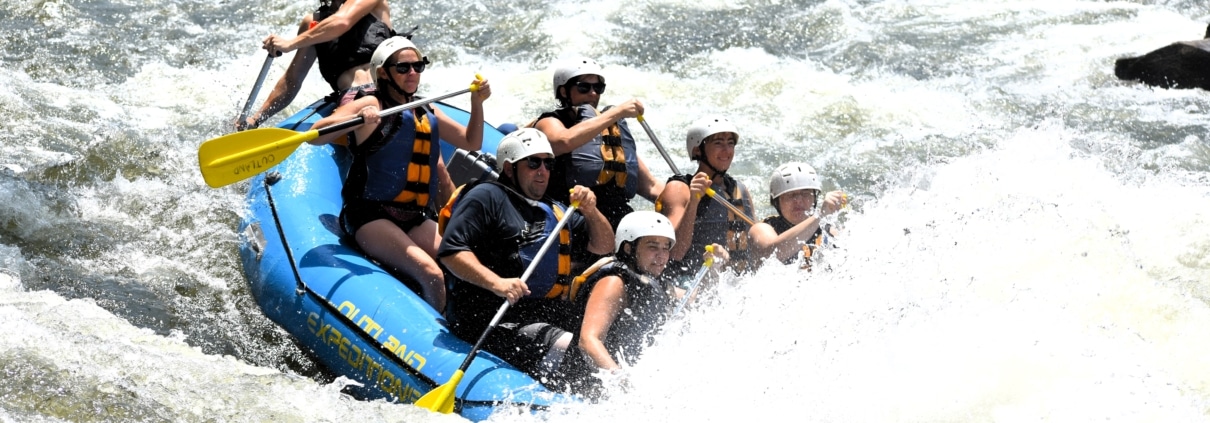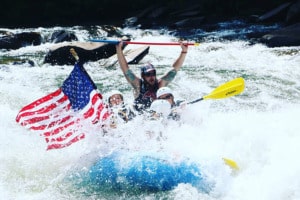Whitewater Rafting History
Whitewater rafting is more than an adventurous sport: it represents the evolution of river rafting used by Native Americans and explorers throughout the history of North America. Rafting, as we know it today, has many components that have led to its current iteration. Here are five significant time periods in whitewater rafting history:
Before 1810
For about 15,000 years, the Nez Perce and other Native American tribes lived along the Columbia River and the Snake River. Because the Columbia River and Snake River were an essential food source for the tribes, they developed the skills and equipment necessary to float on the rivers.
During the Lewis and Clark expedition in the early 1800s, the Nez Perce living along the Clearwater River in Idaho were the ones who provided the explorers with boats and guides for their explorations. Their river rafting trip from Idaho to the Pacific Ocean took about two months.
The 1800s
The first rubber raft used for exploration was used by John C. Fremont for an expedition through Kansas and Nebraska. The rubber raft performed well, although it flipped twice during the expedition due to being overloaded with equipment. Fremont later wrote that had he used wooden boats, they would have been destroyed while the rubber of the raft had “preserved her from every shock.”
One of the earliest whitewater rafting trips occurred in 1869 when John W. Powell led a rafting expedition to explore the Green and Colorado Rivers. Powell’s expedition used wooden boats to ride the Green River rapids in Wyoming all the way down to the Colorado River rapids in the Grand Canyon in Arizona.
1900 Through 1950
Attempts to commercialize river rafting began in earnest around World War II. The first commercial white water rafting trips occurred along the Salmon River in Idaho. The rafting company used surplus rubber rafts from the war to traverse the rapids safely. River rafting slowly grew in popularity through the 1940s, primarily among outdoor enthusiasts and adventurers.
The 1950s and 1960s
The American Whitewater Affiliation was founded in 1954 to promote white water rafting as a sport and preserve wilderness areas for rafting. The group developed the classification system used to rate the difficulty of rivers for rafting. The classifications range from I through VI, with Class I being the easiest and Class VI being the hardest.
- Class I: Fast moving water with riffles and small waves.
- Class II: Straightforward rapids with wide, clear channels which are evident without scouting.
- Class III: Rapids with moderate, irregular waves which can swamp an open canoe and may be difficult to avoid.
- Class IV: Intense, powerful but predictable rapids requiring precise boat handling in turbulent water.
- Class V: Extremely long, obstructed, or very violent rapids which expose a paddler to added risk.
- Class VI: These runs have almost never been attempted and often exemplify the extremes of difficulty, unpredictability, and danger.
These classifications are still in use today, although they differ from the international scale used outside the United States.
1970s through 1990s
Whitewater rafting history and
events grew as an adrenaline sport throughout the 1960s and became Olympic events in 1972. While the subsequent four Olympics retained flat water canoeing, white water events disappeared from the Olympics until the 1992 Olympics in Barcelona. Since 1992, white water canoeing and kayaking have been included in every Olympic games.
The Ocoee River venue used for the 1996 Olympics in Atlanta is unique in several ways. First, it is the only natural waterway used for Olympic whitewater competition. This makes the Ocoee River one of the unique places to go white water rafting.
Second, although Atlanta hosted the games, the upper Ocoee River used for the Olympics lies in Tennessee, making this “Atlanta” venue one of the best places to go white water rafting in Tennessee. This segment of the Ocoee River is open to the public for white water rafting and features class III and IV rapids.
Third, the middle Ocoee River is one of the most popular places to go white water rafting in the country. The Ocoee River drops over 1,300 feet in elevation from its source to its mouth. This segment of the Ocoee River includes class III and IV rapids providing near-continuous action over a five-mile stretch.
In sum, the Ocoee River is one of the best places to go white water rafting. It combines the explorer and adventurer spirit from history with the thrill sports of today. When you’re ready to book a whitewater rafting adventure with the best, rely on Outland Expeditions for your next water excursion.





Leave a Reply
Want to join the discussion?Feel free to contribute!